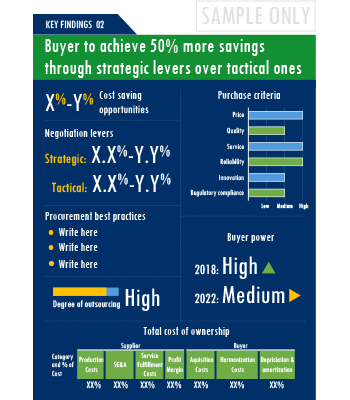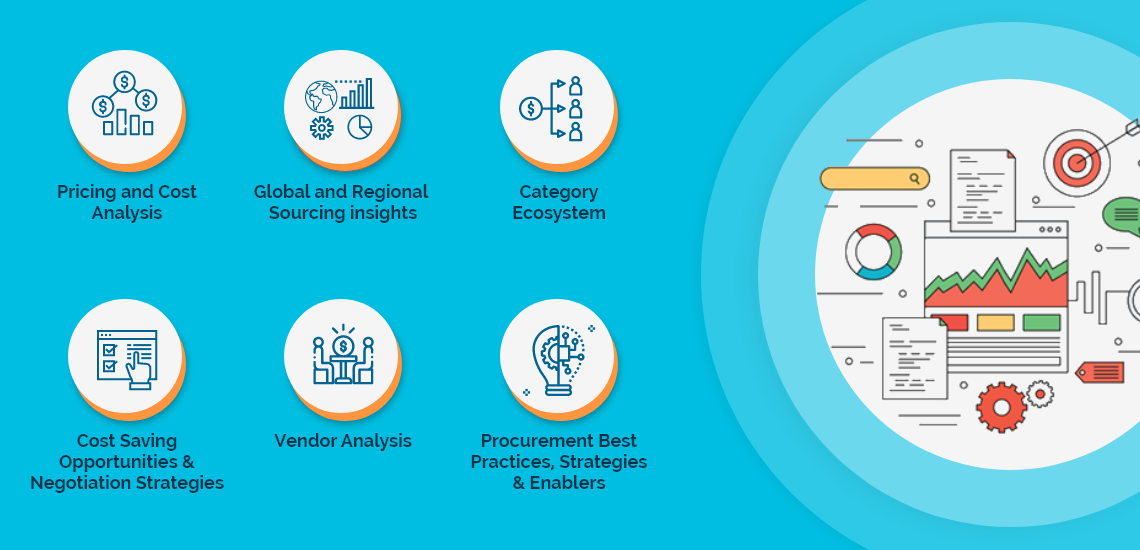Access curated Antihaemorrhagics procurement intelligence and solve all your questions on Antihaemorrhagics procurement outlook, cost saving opportunities in Antihaemorrhagics procurement and potential Antihaemorrhagics partners.
GET FREE SAMPLEAntihaemorrhagics is an essential part of the Drugs and Biological category which includes all spend related to pharmaceutical products used in the treatment, cure or prevention of a disease or to promote well being within human beings. The category also encompasses spend on containment of diseases or temporary relief from chronic disorders.
Drugs and Biological market around the world is undergoing rapid transitions that have a massive potential to influence the way companies strategize for Antihaemorrhagics procurement and the cost they have to incur. Many suppliers are expanding within the value chain to offer integrated solutions. With this new approach, suppliers can offer a wide portfolio of solutions and position themselves for large contracts that go beyond just Antihaemorrhagics. Buyers also find the benefits of volume buying, consolidation of supplier base, efficient co-ordination in case of an event and less spending on category management. Companies that serve multiple markets are increasingly facing the dynamism in regulatory frameworks across countries. Coupled with increased costs across the value chain, suppliers are hard pressed to alter their business models and pricing structures to remain relevant in the market. New locations and vendors are emerging as cost effective suppliers of Antihaemorrhagics, offering an opportunity to widen the supplier base and gain further negotiation leverage with incumbent suppliers.
It has become imperative for category managers to remain as agile as possible in terms of their procurement practices. However, it is not always easy to quickly spot and implement alternative practices in a category like Antihaemorrhagics. To help quick decision making, this report advises on several procurement best practices that have worked well for category managers. For example, It is important for category managers to track and measure the performance of suppliers against a set of defined KPIs that are agreed upon during the contract negotiation phase. The performance of suppliers can also be linked to a portion of their fee that can be paid upon rendering of services in a satisfactory manner.Category buyers should invite bids from all potential service providers that have the ability to meet the overall requirements. Bids must be evaluated based on pre-defined parameters such as financial strength, reputation, offerings, geographical presence, and track record. Buyers can use standard scorecards to evaluate service providers and provide necessary feedback to rationalize the given scores. This helps in the effective documentation of decision-making processes.Category managers must ensure that they have clearly identified and listed down potential negotiation levers to maximize the value of their category spend before entering into contract-related discussions with service providers. Common negotiation levers to maximize value include deadlines, terms related to payments, (including fees, expenses, and payment timelines) and assistance required from the buyer's organization.
Activate your free account to gain easy access to cutting edge research and insights on consumers, emerging price trends, global and regional suppliers.
Antihaemorrhagics procurement managers also need to proactively identify and mitigate potential risks that can arise in the supply chain or contracts for Antihaemorrhagics procurement. Some examples include:
For detailed insights and complete access to our report library, activate your free account!
The report is intended to serve as a one-stop reference guide for Antihaemorrhagics procurement strategy and offers a perfect blend of category basics with deep-dive category data and insights. Therefore, it is ideal for category beginners looking for “Antihaemorrhagics: Procurement Report 101” as well as for category experts actively tracking the global Antihaemorrhagics procurement market.
You may have just initiated your research to design a winning Antihaemorrhagics procurement strategy, or you may be a category expert looking for strategic insights and updated data.Either ways, the report has your requirements covered.

Unlock SpendEdge's comprehensive procurement report collection with ease through our procurement platform.
Procurement decisions can prove to be costly in the absence of careful deliberation and evaluation of every available option. In fact, more than 90% of the decision makers we work with acknowledge that timely availability of up-to-date category intelligence can help them make better purchasing decisions. More than 80% of them believe that in-house category intelligence needs to be updated periodically to achieve full benefits. If you have read so far, we are quite sure you agree!!
The Antihaemorrhagics procurement report helps take more informed decisions by placing all the critical information and advice at the fingertips of a decision maker. It also specifically answers some of the key questions that we have been routinely asked during our industry outreach initiatives:
SpendEdge Insights has helped procurement professionals and sourcing teams manage multiple spend areas and achieve more than $2 billion in savings. Activate your free account today!
The Antihaemorrhagics market report offers a complete picture of the supply market and analyzes the category from the perspective of both buyers and suppliers. Analysis of the category trends, procurement best practices, negotiation levers and overall category management strategy advisory are interspersed with in-depth data and commentary on spend outlook, pricing ecosystem and supplier landscape drilled down to a region-level coverage.

A key highlight of this report is the in-depth outlook created on Antihaemorrhagics procurement spend and pricing trends. The report further delves deep into the aspects of cost structure, total cost of ownership and supplier margins for Antihaemorrhagics. A dedicated section to supplier profiles and evaluation helps decision makers cast a wider procurement net and identify gaps in existing relationships.

Along with specific category and supplier intelligence, the publication also includes curated insights on Antihaemorrhagics market trends, price influencers and inherent risks. These insights help the decision makers prepare for market shaping trends in advance and create alternative strategies for changes in the market conditions.

Additionally, the report also advises on the best practices and strategies to manage the Antihaemorrhagics category efficiently. Negotiation levers and opportunities are explained in detail along with quantification of their potential. Benchmark KPIs for supplier and buyer performance management are also aggregated to better organize the category objectives. Other themes of advisory include ideal procurement organization structure, enablers to achieve KPIs or category objectives and ideal SLAs to have with suppliers.






Our research is complex, but our reports are easy to digest. Quantitative analysis and exhaustive commentary is placed in an easy to read format that gives you an in-depth knowledge on the category without spending hours to figure out “what does it mean for my company?”


SpendEdge presents a detailed picture of Antihaemorrhagics procurement solutions by way of study, synthesis, and summation of data from multiple sources. The analysts have presented the various facets of the market with a particular focus on identifying the key category influencers. The data thus presented is comprehensive, reliable, and the result of extensive research, both primary and secondary.

Global Vasoprotectives Market - Procurement Intelligence Report

Global Beta-Blocking Agents Market - Procurement Intelligence Report

Global Antithrombotic Agents Market - Procurement Intelligence Report

Global Cardiac Therapy Medicinal Products Market - Procurement Intelligence Report

Global Blood Substitutes And Perfusion Solutions Market - Procurement Intelligence Report

Global Renin-Angiotensin System Acting Agents Market - Procurement Intelligence Report

Global Calcium Channel Blockers Market - Procurement Intelligence Report

Global Antihaemorrhoidals For Topical Use Market - Procurement Intelligence Report

Global Diuretics Market - Procurement Intelligence Report
Access this report and our entire procurement platform | Plans starting from USD 3000/ Year Buy Now
Copyright © 2025 Infiniti Research Limited. All Rights Reserved. Privacy Notice – Terms of Use – Sales and Subscription
Cookie Policy
The Site uses cookies to record users' preferences in relation to the functionality of accessibility. We, our Affiliates, and our Vendors may store and access cookies on a device, and process personal data including unique identifiers sent by a device, to personalise content, tailor, and report on advertising and to analyse our traffic. By clicking “I’m fine with this”, you are allowing the use of these cookies. You may change your settings based on a legitimate interest at any time, by selecting “Manage Settings” on our site. Please refer to the help guide of your browser for further information on cookies, including how to disable them. Review our Privacy & Cookie Notice.
